
Alphonsus is an ancient impact crater on the Moon that dates from the pre-Nectarian era. It is located on the lunar highlands on the eastern end of Mare Nubium, west of the Imbrian Highlands, and slightly overlaps the crater Ptolemaeus to the north. To the southwest is the smaller Alpetragius. The crater name was approved by the IAU in 1935.

Arzachel is a relatively young lunar impact crater located in the highlands in the south-central part of the visible Moon, close to the zero meridian. It lies to the south of the crater Alphonsus, and together with Ptolemaeus further north the three form a prominent line of craters to the east of Mare Nubium. The smaller Alpetragius lies to the northwest, and Thebit is to the southwest along the edge of the mare.

Plinius is a prominent lunar impact crater on the border between Mare Serenitatis to the north and Mare Tranquilitatis to the south. Its diameter is 41 km. The crater is named after the Roman natural scientist and author Pliny the Elder. To the south-southeast of Plinius is the crater Ross, and to the northeast is Dawes. Just to the north is a system of rilles named the Rimae Plinius and touching it is the Brackett crater which is more than a crater diameter north. At the northwest edge of the rille is the Promontorium Archerusia, a cape off the western rim that encloses the Mare Serenitatis.
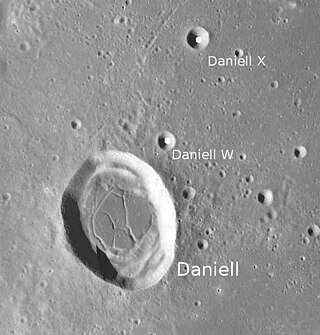
Daniell is a lunar impact crater located in the southern half of the Lacus Somniorum. To the south-southeast is the much larger crater Posidonius. The Rimae Daniell rille system are to the west of Daniell crater.
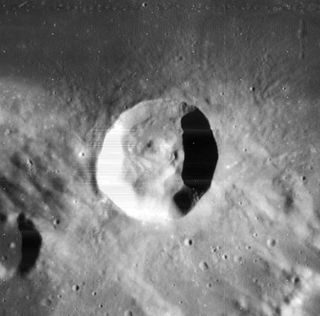
Menelaus is a young lunar impact crater located on the southern shore of Mare Serenitatis near the eastern end of the Montes Hæmus mountain range. Its diameter is 27 km. To the southwest is the small crater Auwers, and to the west-southwest is the even smaller Daubrée. To the northeast is a faint rille system named the Rimae Menelaus.
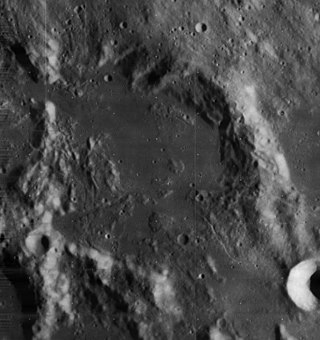
Murchison is a lunar impact crater on the north edge of the Sinus Medii. It was named in honour of the geologist Sir Roderick Murchison. It shares a section of rim with the crater Pallas. To the southeast on the mare is the circular crater Chladni, and to the northeast is Ukert. Farther to the east is the prominent Triesnecker. Murchison lies astride the lunar zenith line, i.e. the starting longitude of the selenographic coordinate system.
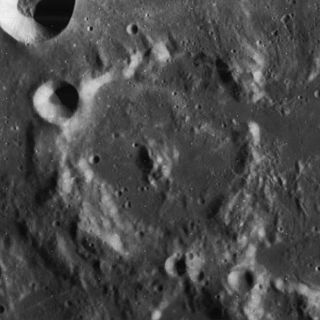
Pallas is a heavily eroded lunar impact crater located to the north of the Sinus Medii. It was named after the German-born Russian natural historian Peter Simon Pallas. To the northwest is the smaller but less worn crater Bode. Pallas shares a low wall with the crater Murchison that is attached to the southeast, and there are two gaps in the shared rim.
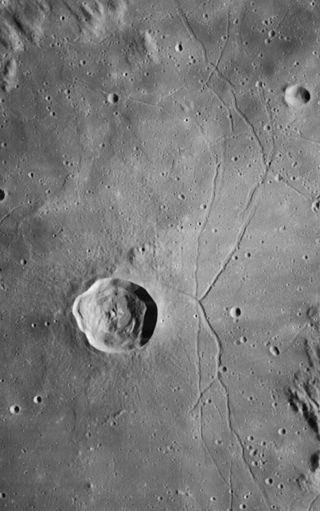
Triesnecker is a prominent lunar impact crater that is located in the Sinus Medii, near the central part of the Moon's near side. Its diameter is 25 km. It was named after Austrian astronomer Franz de Paula Triesnecker. It is located to the north-northwest of the crater Rhaeticus, and to the east-southeast of the flooded Murchison.

Boscovich is a lunar impact crater that has been almost completely eroded away by subsequent impacts. It is located west-northwest of the crater Julius Caesar, and south-southeast of the prominent Manilius. The crater floor has a low albedo, and the dark hue makes it relatively easy to recognize. The surface is crossed by the rille system designated Rimae Boscovich that extends for a diameter of 40 kilometres. The crater is named after Croatian physicist Roger Joseph Boscovich.

Dionysius is a lunar impact crater that lies on the western edge of the Mare Tranquillitatis. It was named after Dionysius the Areopagite. To the southeast is the crater pair of Ritter and Sabine. Just to the northwest is the system of rilles designated Rimae Ritter. These clefts follow a generally northwest direction.

Flammarion is a lunar impact crater on the south edge of Sinus Medii. Its diameter is 76 km. It is named after the French astronomer Camille Flammarion. It is located between the crater Mösting to the northwest and Herschel to the southeast. The bowl-shaped Mösting A intersects the western rim of Flammarion.

Julius Caesar is a lava-flooded lunar impact crater with a low, irregular, and heavily worn wall. Its diameter is 85 km. It was named after Roman statesman Julius Caesar. It is located to the west of Mare Tranquillitatis, and directly southeast of the crater Manilius on the Mare Vaporum. To the east is the rounded Sosigenes.

Littrow is a lunar impact crater that is located in the northeastern part of the Moon's near side, on the east edge of Mare Serenitatis. Its diameter is 29 km. The crater is named after Bohemian astronomer Joseph Johann von Littrow (1781–1840). Some distance to the northeast is the prominent crater Römer, while to the south is Vitruvius.
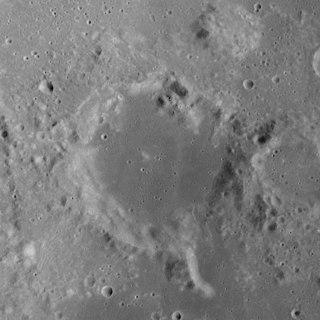
Maraldi is a worn, eroded crater on the western edge of the Sinus Amoris, in the northeast part of the Moon. To the west-southwest is the crater Vitruvius, and to the northwest lies the worn Littrow crater. Just to the northeast of the crater is the dome-like Mons Maraldi rise.

Sosigenes is a lunar impact crater on the west edge of Mare Tranquillitatis. Its diameter is 17 km. It was named after ancient Greek astronomer Sosigenes of Alexandria. It lies to the east of the large walled plain Julius Caesar. The crater rim has a high albedo, making it relatively bright. It has a small central rise at the midpoint of the floor.

Sulpicius Gallus is a small, bowl-shaped lunar impact crater that lies near the southwestern edge of the Mare Serenitatis. The crater is named after the 2nd century BC Roman astronomer Gaius Sulpicius Gallus.
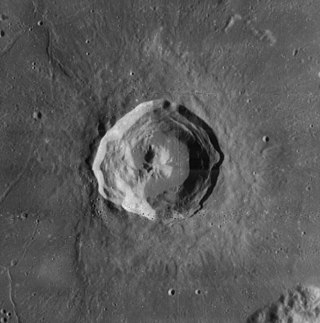
Bürg is a prominent lunar impact crater in the northeast part of the Moon. It lies within the lava-flooded, ruined crater formation designated Lacus Mortis. To the south and southeast is the crater pair Plana and Mason. To the west, beyond the rim of Lacus Mortis, is the prominent crater Eudoxus.

Godin is a lunar impact crater located just to the south of the crater Agrippa, on a rough upland region to the east of Sinus Medii. Its diameter is 34 km. The crater was named after 18th century French astronomer Louis Godin. The ruined crater Tempel lies to the northeast, on the east side of Agrippa. Due south is the flooded remains of Lade.

Dunthorne is a small lunar impact crater that is located to the northwest of the small lunar mare called Palus Epidemiarum, in the southwest part of the Moon's near side. It was named after British astronomer Richard Dunthorne. It lies to the southwest of the crater Campanus, east of Vitello. Due south is Ramsden.





















